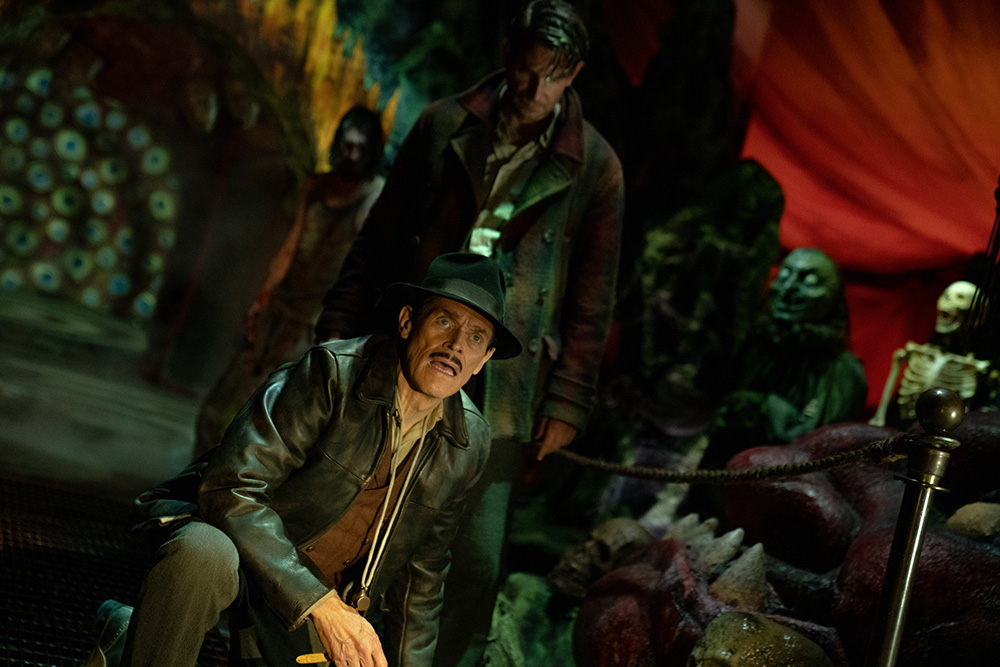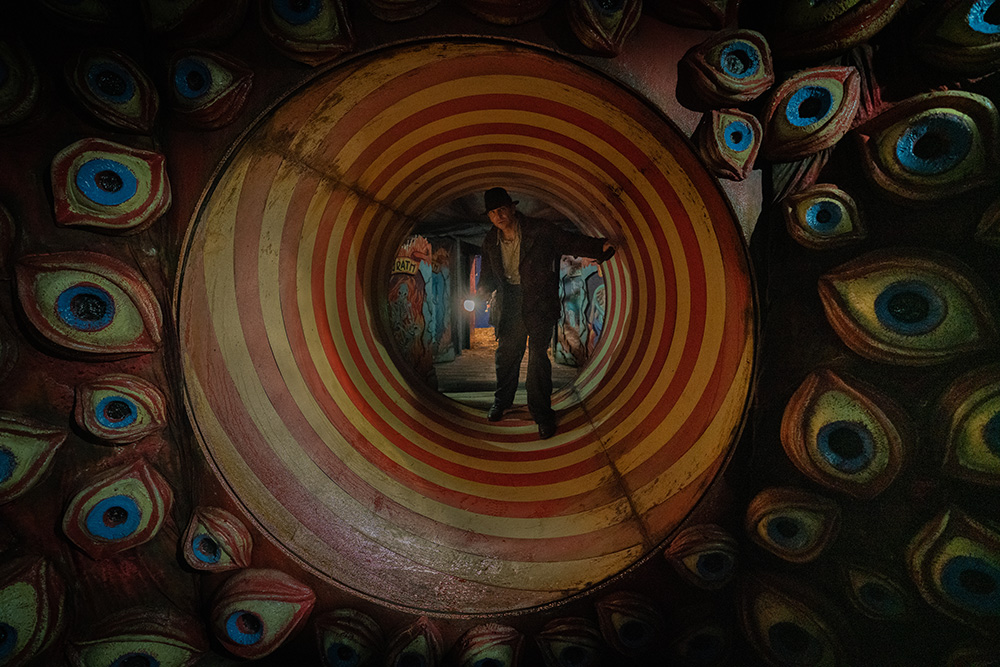No man can outrun God.
We meet Stan Carlisle (Bradley Cooper) dragging a wrapped body to a hole he’s made by wrenching up the floorboards of an old farmhouse. He lights a cigarette and throws the match in too, leaving as the building becomes engulfed in flames. Was it murder? Making good on a promise? We don’t yet know. Whatever it was that put him in this situation was at least dramatic enough for him to keep his head down while traveling by train to the end of the line. It’s there that he sees the circus lights beckoning him in with the promise of solace. Ringleader Clem (Willem Dafoe) is an opportunist who sees cheap labor. His resident mentalist Zeena (Toni Collette) sees a pretty face. Soon Stan is yearning for more.
It’s a very different opening from the one we saw in Edmund Goulding‘s original adaptation of William Lindsay Gresham‘s novel Nightmare Alley. That one saw Stan as a well-established young carnie bestowed the charm and intellect necessary to walk his way into Zeena’s old act with her now drunkard husband Pete (David Strathairn). Director Guillermo del Toro and co-writer Kim Morgan render their lead with a much rougher demeanor. He’s stoic, mysterious, and completely out of his element. He is a quick study, though. And he sees the potential of riding with a crew that doesn’t ask questions and can’t offer enough to hold his growing aspirations at bay. Soon he hatches a plan to take Pete’s intricately coded telepathy grift system back to a respectable city stage.
He’ll do it with the resident electric girl, Molly (Rooney Mara). She’s beautiful and naïve—perfect for the show and his control. And it’s a clean break devoid of jealousy this time around. Neither from Zeena (she has no allusions about her flirtations with Stan) nor Ron Perlman‘s strongman Bruno (who’s an old family friend protecting Molly rather than her boyfriend). Showing Clem’s circus at all is merely a means to establish how a drifter with a dark past haunting his dreams rises from the ashes to become a silver-tongued con man reveling in the power success brings. That and the introduction of an act known as the “Geek.” This is a man manipulated and dehumanized into a crazed junkie desperate enough to do anything for a fix.

This brutalized creature is the flesh and blood mirror for mankind’s avarice. Much like the funhouse reflections asking viewers to “Take a look at yourself, sinner,” the “Geek” reminds the carnies what it is that matters most. I think del Toro should have kept a line from the original film wherein Clem admits troupes with a “Geek” often have difficulty maintaining other acts due to inevitable pangs of morality. It would further prove just how desperate the rest of his employees are to stay relevant enough to never have to wonder if they’ll be next in the cage. He is therefore the consummate mark, forever unable to recognize his own self-worth. And he’s forever anonymous too since nobody dares discover whether his path reminds them of their own.
Who then will Stan learn a lesson from? Will it be Clem and his ruthless penchant for doing whatever it takes to line his pockets and maintain control? Will it be Zeena and Pete with their first-hand experience of what happens when you fly too close to the sun with a con that can trick you into believing the lie? Or will it be the “Geek” and his warning to remain vigilant by never taking one step too many no matter how great the reward? The answer won’t be delayed too long once Stan and Molly find themselves headlining a much talked-about show in Buffalo, New York (where part of the film was shot—see City Hall’s art deco architecture doubling as Dr. Ritter’s office building).
The code works and Stan’s confidence grows with every mistake that forces him to cold read with near perfect results. Not only does he evade the aforementioned Dr. Ritter’s (Cate Blanchett) attempt to expose him as a charlatan, but he also makes a fool of her for added laughter and clout. Enough that an older, wealthy gentleman finds himself a convert asking for a private séance in order to speak with his deceased son. Zeena and Pete warned about such “spook shows.” They knew the power of using a mark’s vulnerability to fleece him/her out of money too well. Molly pleads for Stan to stop, but we knew the second he went off-leash at the circus opposite a local sheriff (Jim Beaver) that there was no turning back.
Doing it means resources and Ritter’s position as a psychologist for the rich provides ample information to string clients along. Is doing it about giving them closure? Is it akin to the ways in which preachers lessen the burden of guilt and regret in their parishioners? (del Toro and Morgan ignore the reverend angle completely this time around and simply allude to the comparison as metaphor.) Or is it criminal? If Stan were being honest, he’d probably say it’s a bit of both since his cutthroat nature is often undercut by an authentic desire to do good. Knowing how a client will take the experience isn’t an exact science, though. Good people can get hurt and bad people (Richard Jenkins‘ reclusive Ezra Grindle) can become emboldened.

If all that sounds like the classic 1947 film: you’re right. Everything is here with some subtle differences in the handling of characters like Pete (Strathairn is a highlight despite having much less time on-screen than you might expect) and Grindle (del Toro skews more towards the novel’s depiction). The fact this one is forty-minutes longer is therefore very noticeable. I could see where things could be streamlined because I knew where they were eighty years ago. That’s not to say there aren’t also marked improvements, though. This is a bleak story that puts far more focus on the idea of the “Geek” than before even if I must admit the way Goulding and screenwriter Jules Furthman mirrored Pete and Zeena’s trajectory was perhaps the better narrative choice.
I really like Mara’s Molly here, though. She has a lot more agency (which isn’t surprising considering the era in which the first adaptation was filmed) and forces us to see that Stan is a lost soul losing his way further with every step he takes. Blanchett’s Ritter is great too with a much sharper edge and a payoff that resonates more thanks to it possessing a legitimate angle (no matter how cliché that angle ultimately proves). The production design is wonderful (with or without my enjoyment of seeing hometown sets) and the noir tone consistent even if the whole is way too dark. Despite those upgrades, however, it’s tough not to feel like the added time is bloat or that Cooper is perhaps miscast in the lead.
That last point may be more of a directing issue, though, as it seems del Toro wants Stan to be a monotonous bore. Even when he’s excited, he’s too measured for us to necessarily care about what he does (besides his glee in the scene where he makes Molly an electric chair). It’s almost like we’re not supposed to ever see Stan as more than a man awaiting a fall, but that only makes said fall anticlimactic as a result. If we never believe he can prevail (something that Tyrone Power‘s performance allows), we’re constantly waiting for the other shoe to drop and thus becoming as frustrated as Grindle demanding to see his dead lover’s bloodied body walking through his garden. It’s missing a spark to truly soar.
photography:
[1] Bradley Cooper in the film NIGHTMARE ALLEY. Photo by Kerry Hayes. © 2021 20th Century Studios All Rights Reserved
[2] Rooney Mara and Bradley Cooper in the film NIGHTMARE ALLEY. Photo by Kerry Hayes. © 2021 20th Century Studios All Rights Reserved
[3] Willem Dafoe and Bradley Cooper in the film NIGHTMARE ALLEY. Photo by Kerry Hayes. © 2021 20th Century Studios All Rights Reserved

